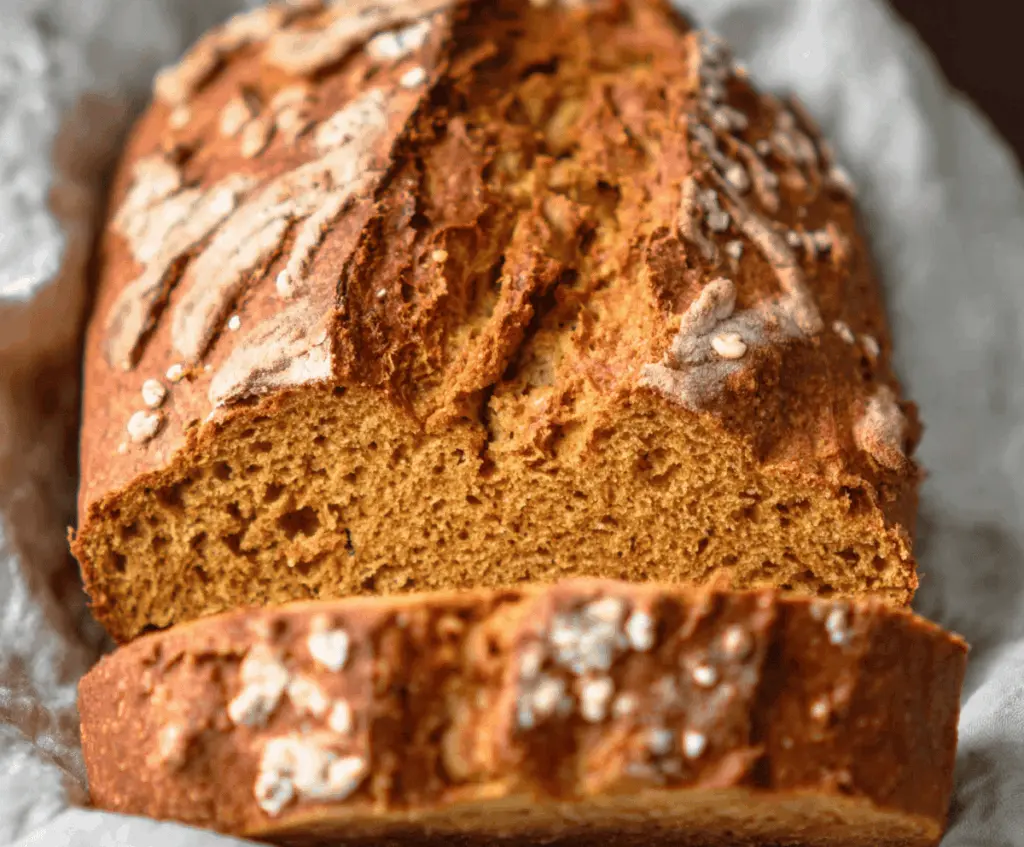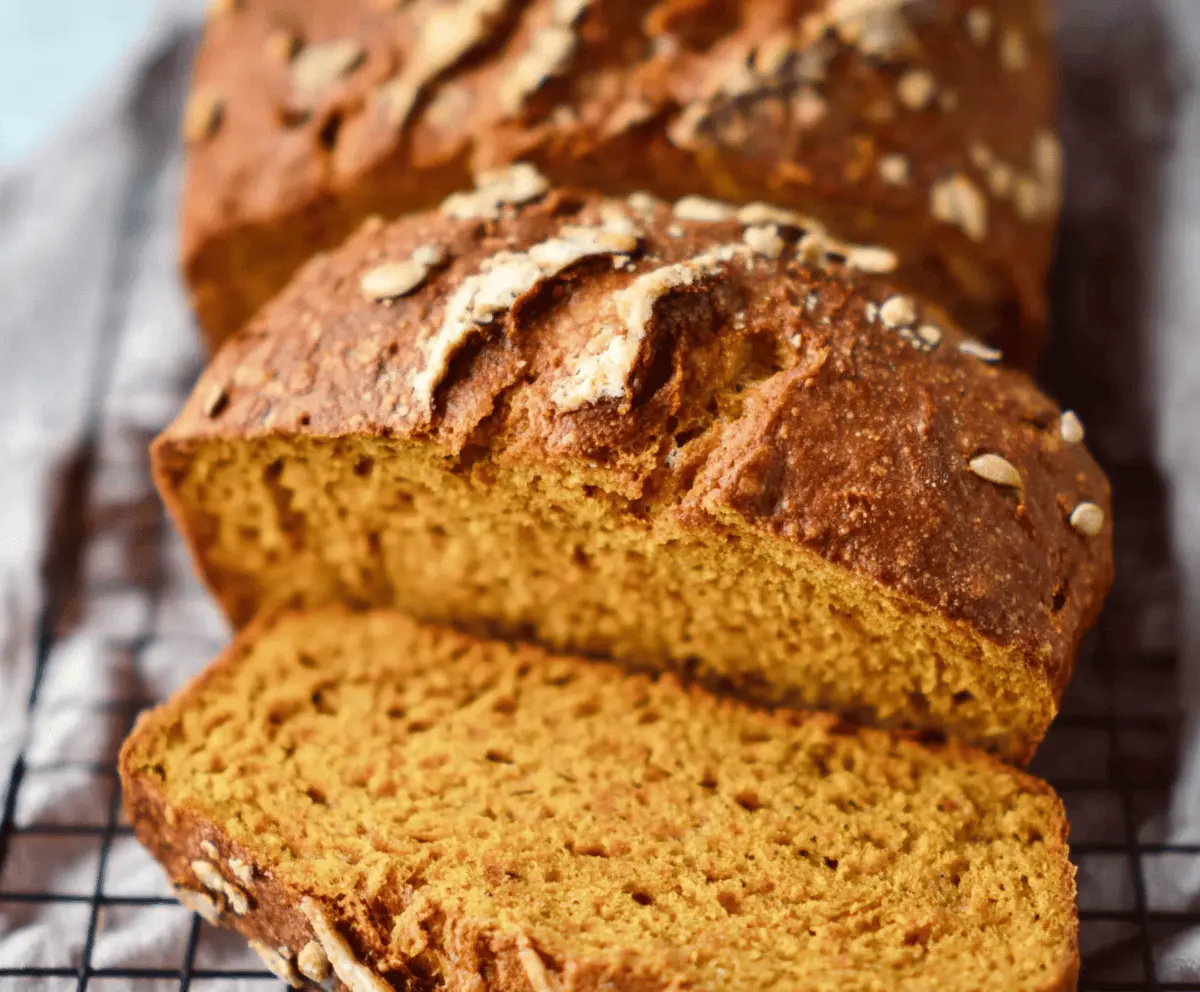
Pumpkin Sourdough Bread
Pumpkin Sourdough Bread is a wonderful twist on classic sourdough with a hint of pumpkin that brings warmth and a touch of sweetness to every bite. The crust is nice…
Tip: save now, cook later.Pumpkin Sourdough Bread is a wonderful twist on classic sourdough with a hint of pumpkin that brings warmth and a touch of sweetness to every bite. The crust is nice and crispy, while the inside stays soft and full of that gentle pumpkin flavor. It’s a perfect combo that feels cozy and satisfying.
I love making this bread when the weather starts to cool down because it smells amazing while baking and fills the whole house with a comfy pumpkin scent. Plus, the sourdough adds a nice tang that balances out the pumpkin’s natural sweetness just right. I usually add some cinnamon or nutmeg to bring out that fall vibe even more.
One of my favorite ways to enjoy this bread is lightly toasted with a bit of butter or cream cheese spread on top – it’s simple but so good. It’s great for breakfast, a snack, or even alongside a bowl of soup. I always find that pumpkin sourdough brings a little extra joy to any meal, and it’s a hit with friends and family too!

Key Ingredients & Substitutions
Sourdough starter: This is the heart of your bread! Make sure it’s active and bubbly for a good rise. If you don’t have one, you can try using commercial yeast, but the flavor won’t be quite the same.
Pumpkin purée: Use plain pumpkin purée, not pumpkin pie filling, to avoid extra sugar and spices. You can use homemade or canned pumpkin. Sweet potato or butternut squash purée can also work as a substitute.
Flour: The mix of all-purpose and whole wheat flour gives a nice balance of texture and flavor. If you want a lighter loaf, use all all-purpose flour. For more nutrition, try spelt or rye flour but expect a denser bread.
Spices: Cinnamon, nutmeg, and ginger add warmth and depth. You can adjust quantities or leave out the ginger if preferred. Adding a pinch of cloves or allspice can be a nice variation too.
Sweetener: Sugar or honey is optional but helps feed the starter and boosts fermentation. If you want a less sweet bread, leave it out, but expect a milder rise.
How Do I Get a Good Rise and Soft Crumb with Pumpkin in Sourdough Bread?
Pumpkin adds moisture and weight to the dough, so getting a strong rise and light crumb needs some attention.
- Use an active, well-fed sourdough starter for the best lift.
- Don’t add too much pumpkin—stick to the recipe amount to avoid overly wet dough.
- Perform stretch and folds during bulk fermentation to build gluten strength without over-kneading.
- If your dough feels too sticky, add a little flour, but avoid making it dry; the dough should be soft and slightly tacky.
- Give the dough a long, cool proof in the refrigerator overnight. This helps develop flavor and improves structure.
- Scoring the dough just before baking allows good oven spring and prevents cracking in unwanted spots.
Equipment You’ll Need
- Mixing bowl – big enough to hold all your ingredients and let the dough rise comfortably.
- Dough scraper – makes handling sticky dough easier and helps with kneading and shaping.
- Banneton basket or bowl with a clean towel – for the final proof, giving your loaf nice shape and texture.
- Dutch oven or baking stone – helps create a crispy crust by holding steady high heat and steam.
- Sharp knife or lame – to score the dough, allowing it to expand during baking without bursting.
- Kitchen scale – for accurate measuring of ingredients, which is key to sourdough success.
Flavor Variations & Add-Ins
- Mix in pumpkin seeds or sunflower seeds for extra crunch and a nutty touch to the crust.
- Add warm spices like cloves or allspice along with cinnamon for a deeper fall flavor.
- Stir in raisins or dried cranberries to add a sweet pop that pairs well with pumpkin.
- Swap half the pumpkin purée for mashed sweet potato to change the flavor and add natural sweetness.
Pumpkin Sourdough Bread
Ingredients You’ll Need:
Main Ingredients:
- 1 cup (240g) active sourdough starter (fed and bubbly)
- 1 cup (240g) pumpkin purée (canned or homemade, not pumpkin pie filling)
- 3 cups (360g) all-purpose flour (plus extra for dusting)
- 1 cup (120g) whole wheat flour
- 1 ½ tsp salt
- 1 tsp ground cinnamon
- ½ tsp ground nutmeg
- ½ tsp ground ginger (optional)
- 1½ tsp sugar or honey (optional, helps yeast fermentation)
- ½ cup (120ml) warm water (adjust as needed)
- Rolled oats or flour for dusting on top
How Much Time Will You Need?
This recipe requires about 1 hour of active prep time, including mixing and kneading. Then, the dough needs 4-6 hours of bulk fermentation at room temperature, followed by an overnight (8-12 hours) proof in the refrigerator. Baking takes about 40-45 minutes. Altogether, expect around 14 hours from start to finish, most of which is passive time while the dough rises and proofs.
Step-by-Step Instructions:
1. Prepare the Dough:
In a large mixing bowl, combine your active sourdough starter, pumpkin purée, sugar or honey if using, and warm water. Stir well to mix these wet ingredients together nicely.
2. Add Dry Ingredients:
Next, add the all-purpose flour, whole wheat flour, salt, cinnamon, nutmeg, and optional ginger into the wet mixture. Use a wooden spoon or dough whisk to stir everything together until a rough, shaggy dough forms.
3. Knead the Dough:
Transfer the dough onto a floured surface and knead it for about 8-10 minutes until it becomes smooth and elastic. Alternatively, use a stand mixer with a dough hook and knead for 5-7 minutes to save some effort.
4. Bulk Fermentation:
Place your dough into a lightly oiled bowl and cover it with a damp cloth or plastic wrap. Let it rest at room temperature for 4-6 hours. During the first 3 hours, perform stretch and folds every hour to help strengthen the dough.
5. Shape the Loaf:
After bulk fermentation, gently turn your dough onto a floured surface. Shape it into a round or oval loaf, then place it seam-side up in a banneton basket or a bowl lined with a clean, floured kitchen towel.
6. Proof the Dough:
Cover and refrigerate the shaped dough overnight, or for 8-12 hours. This slow final proof deepens flavor and improves texture.
7. Preheat Oven:
Before baking, preheat your oven to 475°F (245°C) with a Dutch oven or baking stone inside for at least 30 minutes to get it very hot.
8. Score and Bake:
Carefully turn the dough out onto parchment paper. Dust the top with flour or sprinkle with rolled oats. Use a sharp knife or a lame to make a few slashes on top of the loaf. Transfer the dough (with parchment paper) into the hot Dutch oven or onto the baking stone.
9. Bake Covered:
Cover with the lid if using a Dutch oven, and bake for 20 minutes. This traps steam, helping create a crispy crust.
10. Bake Uncovered:
Remove the cover and bake for another 20-25 minutes, until the crust is deeply golden brown and the loaf sounds hollow when you tap it.
11. Cool and Serve:
Transfer your bread to a wire rack and let it cool completely before slicing. This ensures the crumb sets properly and you get perfect slices every time.
Enjoy your soft, slightly sweet, and warmly spiced pumpkin sourdough bread—it’s wonderful toasted with butter or cream cheese, or simply as is!
If you enjoyed this rustic loaf, try my cozy Pumpkin Chocolate Chip Bread, fluffy Pumpkin Spice Pancakes, and the ultra-moist Easy Pumpkin Bread with Cream Cheese Swirl.
Can I Use Frozen Pumpkin Purée for This Recipe?
Yes, frozen pumpkin purée works great! Just thaw it completely in the fridge or at room temperature before using. Make sure it’s well-drained if any excess liquid is present to avoid a soggy dough.
How Should I Store Leftover Pumpkin Sourdough Bread?
Store leftover bread in a paper bag or bread box at room temperature for up to 3 days to keep the crust crisp. For longer storage, slice and freeze the bread in an airtight bag for up to 3 months. Toast slices directly from frozen for best flavor.
Can I Add Other Ingredients to the Dough?
Definitely! Pumpkin seeds, nuts, dried cranberries, or raisins make tasty additions. Fold them in gently after the initial mix but before bulk fermentation to distribute evenly.
What If My Dough Feels Too Sticky During Kneading?
If it’s too sticky, sprinkle in a little extra flour, a tablespoon at a time, and knead gently. Be careful not to add too much or the bread may turn out dense instead of soft.
